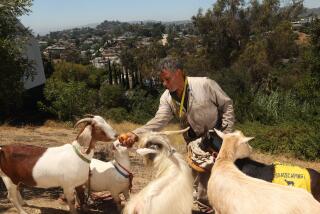Island Refugees : Keeper Gets Her Goats, 63 of Them
- Share via
RAMONA — A truckload of 63 goat refugees from San Clemente Island were brought here Thursday morning and left in 80-year-old Patricia Nelson’s front yard.
She didn’t bat an eye.
Nelson simply added them to her tally of other animals that she cares for until they are adopted. There are 97 dogs, 40 cats, 35 rabbits, a horse, a donkey and, now, 63 goats to add to the 14 she already had.
From her four-acre ranch in this rural community in northern San Diego County, Nelson runs the Animal Trust Sanctuary, a 13-year-old project to care for unwanted animals until they find homes. But unlike people at many animal shelters, Nelson pledges to care for them until they are adopted. And, indeed, some dogs have been here since the day she opened her kennels 13 years ago.
Officials don’t expect the goats to hang around that long, however.
Once Numbered Almost 30,000
The goats were targeted for death by Navy marksmen because they are believed to be destroying the habitats of some island plants, birds and animals that appear on the national endangered species list. The goats, thought to be descendants of a small herd of Andalusian goats put on the island as long as 200 years ago to provide food for passing sailors, once numbered almost 30,000, according to Navy biologists.
Since the early 1970s, all but the 1,200 to 1,500 now on the island, which is used by the Navy for target practice, have been shot by hunters or trapped. The Navy itself has shipped 15,000 of the animals off the island, and the international Fund for Animals took about 1,000 off the island in 1973 and 1974.
Because of their ability to reproduce rapidly, the goats’ population can quickly became troublesome, and the Navy planned a wholesale goat shoot last month. The Fund for Animals, however, won approval from Defense Secretary Caspar W. Weinberger for one more trapping effort, which is now under way. Author Cleveland Amory, who heads the group, hopes to save 800 of the doomed animals before the time allotted for the recovery effortruns out in the first week of March.
The first batch of 200 wild goats arrived by Navy supply barge at the North Island Air Station on Coronado about dawn Thursday. Of those, 103 were brought here, and the other 97 were trucked to a Los Angeles County animal shelter at Castaic, in the San Fernando Valley.
Of the goats brought to Ramona, 63 were left at Nelson’s sanctuary and the other 40 were taken to holding pens down the road.
The Fund for Animals will begin processing adoptions for the wild goats this weekend, and officials say that based on the amount of interest already generated, all the goats may be claimed before Sunday evening. If not, the adoptions will resume next Friday for another weekend.
Can Make Good Pets
The animals have been vaccinated for tetanus, given penicillin and appear to be “in excellent condition,” said Paula Van Orden, a representative of the group. The goats are docile and, with proper care can make good, affectionate pets, officials say.
Male goats can be adopted for $25; the females will go for $35, and officials hope that since the goats are herd animals, interested people will take home at least two of the same sex.
“Or three or four or five,” said Nelson, always the saleswoman when trying to find homes for animals.
Nelson operated a nursery school in San Diego for more than 30 years before retiring and turning her attention to animals.
“I didn’t want to sit around and do nothing, so I took this venture on,” she said. “And this is rougher than a nursery school because at the end of the day, these don’t go home.”
Nelson employs four helpers to care for her kennels and feed and clean up after the animals. In addition to the payroll, she spends about $1,000 a month on feed.
She relies on donations to meet her costs. People often give her money when they leave an animal with her; others will give her money when they adopt an animal, and there are a handful of regular benefactors. But she receives no government funds, and for all intents and purposes, hers is a private, licensed kennel. Until she gives an animal up for adoption, she owns it.
Hollywood Drop-Off
Word of her project has spread largely by mouth; workers here talk about the day a limousine from Hollywood pulled up, dropping off a dog that was no longer wanted by its master. Apparently, the owner did not want to risk his dog being destroyed, so he delivered it to Nelson’s sanctuary for safe-keeping and possible adoption.
“Anybody can go to a pet store and buy a puppy,” said Betty Navarro, one of the workers. “But when you come here, you give a little of yourself. You’re doing something for the dog. I remember one big, old sheep dog that was blind, and I still remember the man who adopted it.”
Nelson has no family other than the animals. “Isn’t that enough?” she asked.
Is she frustrated that many of the animals haven’t been adopted? “What’s the hurry?” she asked. “I like ‘em.”
Does all that barking keep her awake at night?
“What barking?” she asked.
More to Read
Sign up for Essential California
The most important California stories and recommendations in your inbox every morning.
You may occasionally receive promotional content from the Los Angeles Times.













